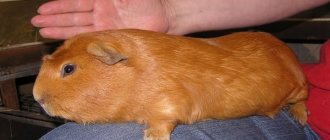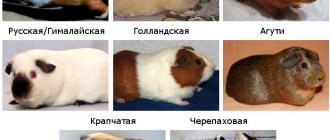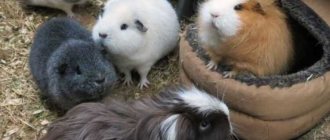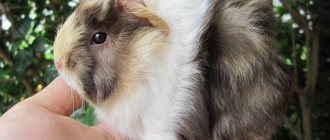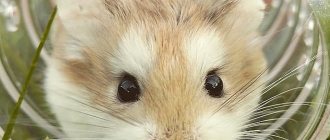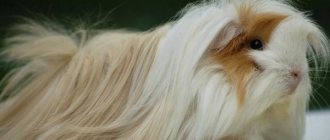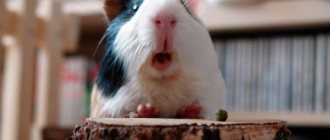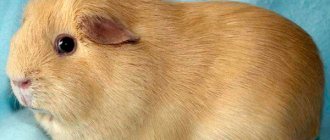History of the breed
Sheltie is the oldest breed among pigs bred by breeders. The first animals with the characteristic features of Sheltie were born at the end of the 39s of the last century. Since then, there has been an intensive formation of the breed, which scientists wanted to reward with excellent immunity, unusual appearance and maintain a friendly character. After forty years of selective development, the Sheltie was officially recognized.
American guinea pigs and Peruvians were used in the breeding work. From them the Sheltie received long, soft fur, pleasant to the touch and of a wide variety of colors.
Origin story
The breed was bred artificially and is considered perhaps the oldest among those already known to the world. The first generation of Shelties was received in 1938; It was based on American and Peruvian guinea pigs. In 1978, the breed was already recognized by many professional breeders.
As a result of experimental crossing, surprisingly cute little animals were obtained, which inherited long hair from American women, and silky and shiny hair from Peruvian women. If you touch a little pig, you will immediately feel a surge of tenderness, its coat is so incredibly soft and airy.
Description and distinctive features of Sheltie
“Silk pigs” is how breeders of representatives of the Sheltie breed are often affectionately called. The pile grows towards the tail from the tip of the nose. The rodent's muzzle is open. The fur growing on the back is much longer than the side fur. Therefore, when you look at a Sheltie, you get a strong feeling that she is covered with a fur blanket.
The coat color can be any. The palette is amazing in its diversity. Multicolored and tortoiseshells are common. Rare and expensive colors include agouti, buffalo, slate (sulphur, blue), and roan. An adult pig is 20–30 cm long and weighs from 800 to 1500 grams.
The length of the pile can reach half a meter. It grows quickly, about 3 cm per month. To make it easier to care for the animal, it is trimmed. If you plan to exhibit the animal, there is no need to cut it, otherwise the judge will be disqualified.
Where to buy Sheltie
You cannot buy a purebred animal at a pet store. Sometimes ordinary long-haired pigs are sold under the guise of Sheltie, and inexperienced buyers overpay thousands of rubles for a representative of a different breed or a completely outbred animal. You can purchase a purebred Sheltie only in a specialized nursery. There are several of them in Russia:
- Crisolina guinea pig nursery in St. Petersburg,
- Guinea pig nursery Gnome in Nizhny Novgorod,
- Guinea pig nursery Amulet in Kaluga,
- Nursery Irish Cream in St. Petersburg,
- Guinea pig nursery Kevi Duna in Tver,
- Rodent nursery in Moscow,
- Guinea pig nursery Looney Land in St. Petersburg,
- Nursery Nord-West in St. Petersburg,
- Calibri guinea pig nursery in St. Petersburg,
- Nursery Vanilla Sky in St. Petersburg,
- Little Inka, Sevastopol,
- Nursery Goshite House in Moscow.
The price for a purebred animal starts from 1,500 rubles and largely depends on color, coat length, exhibition prospects and breeding value. Some representatives of the show class breed can cost up to 10,000 rubles. Baby animals exported from nurseries in Europe and the USA will also cost more.
Sheltie character
These animals are a “barometer” of the microclimate in the family. Can't stand sharp sounds and loud voices. He reacts to an incomprehensible situation by running away. However, the animal’s timidity is surprisingly combined with its unique ability to quickly adapt. In a few days the animal will get used to its home and owners. Usually he himself takes the first steps towards communicating with a person.
It is necessary to gradually introduce the pig to other pets. They feel comfortable in their owner’s arms and enjoy stroking and brushing. They don’t hide the fact that they like it when they scratch behind their ears.
The Sheltie guinea pig does not show aggression. She can behave inappropriately only in an extreme situation (she is scared, she is in pain).
In a good mood and to attract attention, the rodent makes pleasant melodic sounds. Having such a pet in your home will definitely never be boring.
The pig doesn't like to be alone. It is justified to keep such animals in same-sex couples.
Pigs are very interesting to watch. But the most amazing thing is that they also watch the person with curiosity.
Choosing and arranging a home
A regular cage that would be suitable for a hamster or a rat is not suitable for a guinea pig. It should be kept in especially comfortable conditions.
Cage or aquarium
Guinea pigs need a lot of horizontal space. They need constant movement, so a cramped plastic or glass aquarium will not suit them. Choose a low but spacious cage with a low plastic tray.
It is impossible to keep pigs on a mesh floor, as they will develop pododermatitis (skin problems on the limbs). The grid should be longitudinal and frequent so that the pig does not crawl out of the cage. Choose a cage that is at least 90 cm long and more than 70 cm wide.
We recommend that you learn how to choose and arrange a cage for a guinea pig.
Accessories
First of all, pour filler into the tray. Choose a special filler made from paper at the pet store. Straw is suitable for the same purposes. Pour the filler in a thick layer (at least 7 cm) so that the animal can burrow into it, warm itself and make holes. Change the bedding every 3 days, as the animal will dirty it.
Attach a hanging drinker to the cage. A bowl of water is not suitable for these animals, as they love active games and often overturn the cage equipment. This also applies to the feeder. Fasten it securely just above floor level. Give preference to ceramic feeders so that your pet does not chew the bowl or eat plastic. The sides of the feeder should be low so that the pig can eat comfortably.
Guinea Pig Water Bowl Do not install a litter tray for the first 2-3 days. The pig will choose a comfortable corner for itself, and you won’t have to train it to go to the toilet in the same place. Place the tray where the litter will be most dirty, and the cage will be clean.
Buy your pig a wooden house so he can have some privacy. Place him in his cage only at night. An animal that spends all day in a house will become apathetic and fearful.
Did you know? Despite their name, guinea pigs have nothing in common with the sea, Guinea, or pigs.
They are called marine because they came to Europe from the South American continent - because of the sea. The Guinean part of the name arose by accident - Guinea was confused with Guiana, from where these rodents were traded. Finally, these animals are called pigs for their plump, round body and the ability to make squealing sounds, which are how newborn piglets usually communicate.
Singles or need a couple
Pigs are pack animals. They need the company of their relatives, so plan to buy two animals at once if you cannot pay enough attention to your pet. Give preference to same-sex couples to avoid accidental matings. Both males and two females get along equally well—the level of conflict depends on the nature of the animal.
Care and maintenance
The average life expectancy of guinea pigs is 5–8 years and depends on care and maintenance. For the animal to feel comfortable, the home must be spacious. Ideally, the cage dimensions will be 60x100.
A homemade cage is made of such a size that the corner allocated for the animal allows. It is not recommended to replace the cage with an aquarium or dune. They are poorly ventilated, which negatively affects the animal’s well-being.
The cage is placed in a place protected from drafts and direct sunlight. Sawdust, preferably from fruit trees, is used as bedding.
Sheltie pig care is special. Every day you need to pay attention to the fur. Comb the animal with a special comb every day. If it is not possible to do this, you need to trim it, otherwise the hair will quickly mat and become dirty.
You have to bathe the animal at least once every 3 weeks. It is important to make the water comfortable for the animal: it should not be cool or too hot. If you scare your pig with hot water even once, bathing will be problematic.
They use special shampoos for long-haired animals, which contain conditioner balm. Don't assume that human shampoo will do. The hair structure is completely different.
You need to dry the animal as quickly as possible using absorbent wipes and a warm hair dryer. A clean, combed Sheltie is placed in a cleaned, vinegar-disinfected cage.
It is prohibited to use household chemicals, especially those containing chlorine, to wash the cage.
Features of care
Sheltie is not a breed for beginner pig breeders and not for children. These animals require special and very careful care and differ in many ways from representatives of all other breeds.
The animal's long fur requires daily and repeated combing. Ideally, the breeder should comb his pet at least three times a day and remove sawdust, pieces of hay and straw, and other contaminants from the wool. Hair that is too long and prevents the pig from moving freely should be trimmed. However, if the animal will take part in an exhibition, cutting is unacceptable. Animals that are clipped are disqualified. Before an exhibition, it is customary to wrap animal fur in special curlers. There are two explanations for this:
- Curled curls do not interfere with the movement of the guinea pig,
- The animal looks neater and more well-groomed.
At intervals of several hours, the curlers must be removed, the fur combed and curled again.
Proper feeding is important in keeping a Sheltie. Long hair needs a lot of vitamins, so the diet should be dominated by fruits and vegetables rich in carotenes, vitamins C, D, A and E, as well as special mineral premixes containing sulfur, biotin and essential omega acids.
It is not recommended to feed the animal with dry food, as well as food containing fats - this will negatively affect the quality of the coat and its shine.
Cleanliness and cleanliness again
The cage where the Sheltie is kept must be cleaned daily. Otherwise, an unpleasant odor will appear, and the fur will lose its shine due to dust and dirt. Shelties are also different in that they require periodic water treatments. Animals are bathed depending on the length of their fur - from several times a month to once every couple of months. Be sure to wash the animal before exhibitions. They bathe the animals in a basin. Bathing water should be warm - cold will lead to a cold, and hot will cause stress and burns. For washing, a special shampoo designed for guinea pigs is usually used. However, you can replace it with any shampoo for children. It is important that the shampoo contains a balm - otherwise it will be impossible to comb the animal after bathing.
After water treatments, the animal is given time to dry, and then the fur is sprinkled with talcum powder. Typically, breeders dry animals with a hairdryer to avoid colds and other diseases from hypothermia.
Sheltie guinea pig nutrition
The Sheltie's diet differs from that of ordinary rodents. The fast-growing hair of the animal makes adjustments. Products with a high content of vitamins and minerals are required.
The animal should have plenty of fresh vegetables, fruits and herbs, which are added to it as it eats. It can be:
- Chinese cabbage;
- lettuce leaves;
- parsley;
- dill;
- carrots (along with tops);
- clover;
- dandelion;
- apples;
- firm green pears;
- bell pepper
You cannot collect herbs for animals along highways, in places where pets are walked, there is dust, or near hazardous industries.
The pig's teeth are constantly growing and she needs to grind them down. The cage should always have fresh, good-smelling hay and branches of fruit trees. You can purchase special mineral stones that pigs will happily chew on. However, you should not get too carried away with them, so as not to upset the phosphorus-calcium balance.
It is more convenient to purchase a mixture of grains ready-made. At least once a week, the pig is offered a tablespoon of low-fat cottage cheese and kefir.
Beet tops and cabbage leaves should be limited due to the risk of bloating. There must be clean drinking water in the drinking bowl.
If you want to treat your Sheltie with something tasty, you can give him dry cookies or crackers with raisins.
Nuts should be present in the rodent's diet in reasonable quantities, as they are fatty foods. Citrus fruits, chocolate, potatoes, radishes, radishes, garlic, and hot peppers should not be given to pigs.
Nutrition
Since the Sheltie is a rather unusual breed, its diet should contain a large amount of vitamins. It is very important that vitamins A, C, and E are present in the diet. In order to give them to your pet in full, you can purchase special supplements.
You can feed Sheltie fresh vegetables, herbs, hay, grains and even dairy products. However, in the latter case, it is important that the milk or kefir does not contain a large amount of fat.
It is very important that all vegetables and bread are cut into small pieces - this will make it more convenient for your pet. You should not give your guinea pig nuts or seeds - this amount of calories and fat will negatively affect their health.
Make sure there is water in the cage at room temperature. It would also be a good idea to purchase a special stick from a pet store for grinding down your pet’s teeth. Ideally, Sheltie should be fed several times a day in small portions (100-150 g). It is impossible for the animal to “attack” indoor plants or grass growing near the road, landfills, etc.
Reproduction
If there is a goal of breeding a Sheltie breed, select strong, well-developed animals that do not have any malformations or hereditary diseases. You need to pay attention to character. If they show a tendency towards aggression, it is better not to take such animals for procreation. This means that something went wrong during their removal. The Sheltie is a peace-loving animal.
Before the meeting, the animals are well fed with added vitamins. The female is placed in the cage with the male several times. The pregnant pig is kept in a separate cage. They are setting up a closed house where she will give birth to babies.
Pregnancy lasts 60-70 days. No more than five cubs are born at a time. Since the female feeds them exclusively with her milk for the first 15 days, she needs to be provided with an enhanced diet.
While the babies depend on their mother, they cannot be picked up so that the female does not refuse. After a month, the babies are seated according to gender in different cages.
Conditions of detention
In addition to a balanced diet, an active lifestyle affects the health and longevity of your pig. Shelties are inquisitive and restless animals. They need space. The cell area must be at least 0.6 square meters. meters (100*60 cm). But a pet’s life cannot consist only of a house. In winter, the pig should be allowed to run around the room, and in summer, outside on the grass. Lack of free space will turn the Sheltie into a sickly and indifferent animal. The cage needs to be cleaned daily - guinea pigs are not known for their cleanliness. Otherwise, a pungent, unpleasant odor will begin to spread throughout the house.
Rules for choosing when purchasing and price
The price of a Sheltie pig is considerable, reaching up to 10 thousand rubles. To avoid falling into an outbred hybrid that only vaguely resembles a Sheltie, you should buy the animal only in nurseries and pet stores. The choice is complicated by the fact that Sheltie cubs have short hair that lies tightly to the body. It grows fully by the age of six months. Therefore, when buying a two-month-old baby, it is difficult to understand what kind of fur the pet will have.
You need to pay attention to the general condition of the animal. The coat should be shiny and there should be no discharge from the eyes and nose. If an animal sits in the corner with a ruffled look, this is a bad sign. The animal quickly recovers from stress, even if it is frightened by trying to look at it.
An active, affectionate Sheltie will bring a lot of joy to its owners if they give it enough attention.
Description
Pigs of this breed are very calm and friendly, they easily get used to people and their hands. The Sheltie breed is one of the most frequently seen at exhibitions and shows. There are certain standards for the appearance of the Sheltie, which allow us to judge the proper development of the animal and its health.
So, for example, the head of a given guinea pig should not be overly elongated or disproportionate to the rest of the body - its ideal shape is spherical, slightly flattened and smoothly extending at the nose. The eyes are round and small, slightly protruding. The Sheltie's ears are medium in size, covered with thick fur and outwardly resemble a slightly curved flower petal. The body is oblong, reaching up to 30 cm in length in adulthood. The weight of this animal after entering puberty and until old age should not exceed 1.3-1.4 kg.
The Sheltie breed belongs to the long-haired category. The hairs on average reach up to 30 cm in length, their growth line goes back from the muzzle. The coat should be quite dense, without bald spots, smooth and soft. There are many colors of Sheltie. The most popular include:
- Bright red color with golden streaks;
- Beige/sand color;
- Brown;
Less common:
- Black color;
- White color;
- Multi-colored color of white, red and black tones;
- Red color.
- Slate gray.
Frequently encountered shortcomings of the Sheltie that do not allow the pet to participate in exhibitions:
- Brittle wool having a length of less than 25 cm;
- Piebald coat color;
- Curvature of the paws, the presence of clubfoot;
- Disproportional torso, too long or too short;
- Excessively elongated nose, deformation of head proportions;
- Narrow chest and general anemia of the body.
Bathing
If dirt on the fur or paws is easily removed, then it is better to clean the pig with wet wipes or a simple wet rag.
Breeders and professionals bathe Shelties. This allows you to restore the shine to your pet's appearance. Especially in cases where the pig is exhibited. If you still cannot do without bathing, then the animal should be accustomed to this procedure from an early age. Then this situation will not become stressful for the Sheltie. You should bathe your pig no more than once a month. You need to purchase special detergents. As a rule, Sheltie shampoo contains conditioner, which makes the subsequent combing process easier. You cannot wash it with regular shampoo - this can cause allergies in your pet. It is convenient to bathe in a sink, although some owners use a basin and a bathtub. The photo with a Sheltie guinea pig demonstrates how the procedure works.
Sheltie breeding
In order to produce long-haired offspring, it is best to crossbreed a female and a male Sheltie. The result of such a union will be silky guinea pigs.
Another method of breeding would be to cross the Peruvian and American breeds of pigs. The probability of the appearance of long-haired beauties with such a union is 20%. Breeding a new population will take a lot of time. The desired result may not be achieved immediately.
When crossing a Sheltie with a regular pig, the likelihood of a long-haired individual being produced is reduced to zero. Such a union contains the “short-haired” gene, so most likely a rosette guinea pig will be born.
